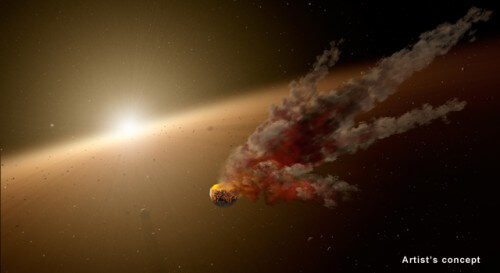NASA's Spitzer Space Telescope has detected an eruption of dust around a young star, which may be the result of a collision between large asteroids. This type of collision can eventually lead to the formation of planets

NASA's Spitzer Space Telescope has detected an eruption of dust around a young star, which may be the result of a collision between large asteroids. This type of collision can eventually lead to the formation of planets.
Scientists were regularly monitoring the star, known as NGC 2,547-ID8, when suddenly there was a spike in the amount of fresh dust around it between August 2012 and January 2013.
"We think two large asteroids collided with each other, creating a huge cloud of dust particles. The asteroids shatter themselves into pieces and move out of the star," says the paper's lead author and graduate student Huan Meng of the University of Arizona in Tucson.
While the dusty remnants of suspected asteroid collisions have been observed by Spitzer in previous events, this is the first time scientists have collected pre- and post-collision data in another solar system. The viewing allows a glimpse into the violent process of creating rocky planets like ours.
Rocky planets begin their lives as dust swirling around young stars. The clumps of matter coalesce to form asteroids that collide with each other. Although such asteroids are often destroyed, some grow over time and become progenitor planets. After about 100 million years the objects mature into full-sized planets. According to the accepted theories, our moon was also formed from a huge collision between the early Earth and a Mars-sized object. From the force of the collision parts of the earth's crust were thrown into space and some of them crystallized and became the moon.
In the new study, Spitzer photographed the dusty star NGC 2,547-ID8, which is about 35 million years old and lies 1,200 light-years away in the southern constellation Vela. Previous observations have already picked up changes in the amount of dust around the star, hinting at possible ongoing asteroid collisions. Hoping to detect an even larger effect, which is a key step in the birth of a terrestrial planet, the astronomers turned to Spitzer to observe some stars regularly. Beginning in May 2012, the telescope began observing these stars, sometimes daily.
A dramatic change in the star that occurred during the time between two Spitzer shots should indicate that NGC 2,547-ID8 is making strides in a direction similar to that of our own Solar System. When Spitzer looked at it again five months later, the team members were stunned by the data they got.
"We are not only witnessing the destruction after the asteroid collision but are also able to follow the changes and in particular the decay signal when the cloud destroys itself by eroding its grains, so that they escape from the star," said Kate Su of the University of Arizona and one of the team of study authors. "Spitzer is the best telescope for regularly monitoring stars and in particular it is able to detect small changes in infrared light over months and even years."
A very thick cloud of dust now surrounds the star in the region where rocky planets form. As scientists, we seek to examine how the infrared light from this cloud changes according to what is visible from Earth. For example, when the elongated part of the cloud is in front of us, a larger part of its surface is exposed and the signal is stronger. When the head or tail of the cloud is visible from our point of view, less infrared light reaches us. By studying the infrared fluctuations, the team for the first time collected detailed data and results of the process of the collisions that form rocky planets like Earth.
"We are watching the formation of rocky planets happening right in front of our eyes," said George Reika, from the University of Arizona and one of the partners in the new study. "This is a unique opportunity to learn about this process in real time up close."
Team members continue to keep an eye on the star through Spitzer. They will further monitor whether the high dust levels subside, which will help them calculate how often such events happen around this and other stars. And they may possibly see more such collisions.
The results of this study were published on Thursday, 28/8/14 in the online issue of the journal Science.
For information on the NASA website
